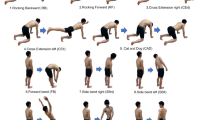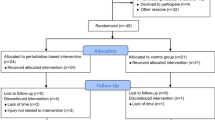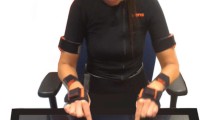Abstract
Purpose
Local dynamic stability of trunk movements quantified by means of the maximum Lyapunov exponent (λmax) can provide information on trunk motor control and might offer a measure of trunk control in low-back pain patients. It is unknown how many repetitions are necessary to obtain sufficiently precise estimates of λmax and whether fatigue effects on λmax can be avoided while increasing the number of repetitions.
Method
Ten healthy subjects performed 100 repetitions of trunk movements in flexion, of trunk rotation and of a task combining these movement directions. λmax was calculated from thorax, pelvis and trunk (thorax relative to pelvis) kinematics. Data series were analyzed using a bootstrap procedure; ICC and coefficient of variation were used to quantify precision as a function of the number of cycles analyzed. ANOVA was used to compare movement tasks and to test for effects of time.
Results
Trunk local stability reached acceptable precision level after 30 repetitions. λmax was higher (indicating lower stability) in flexion, compared to rotation and combined tasks. There was no time effect (fatigue). λmax of trunk movement was lower and less variable than that of thorax and pelvis movements.
Conclusions
The data provided allow for an informed choice of the number of repetitions in assessing local dynamic stability of trunk movements, weighting the gain in precision against the increase in measurement effort. Within the 100 repetitions tested, fatigue did not affect results. We suggest that increased stability during asymmetric movement may be explained by higher co-activation of trunk muscles.




Similar content being viewed by others
References
Maetzel A, Li L (2002) The economic burden of low back pain: a review of studies published between 1996 and 2001. Best Pract Res Clin Rheumatol 16:23–30
Michel A, Kohlmann T, Raspe H (1997) The association between clinical findings on physical examination and self-reported severity in back pain. Results of a population-based study. Spine (Phila Pa 1976) 22:296–303
Radebold A, Cholewicki J, Panjabi MM, Patel TC (2000) Muscle response pattern to sudden trunk loading in healthy individuals and in patients with chronic low back pain. Spine(Phila Pa 1976) 25:947–954
MacDonald D, Moseley GL, Hodges PW (2009) Why do some patients keep hurting their back? Evidence of ongoing back muscle dysfunction during remission from recurrent back pain. Pain 142:183–188
Van Dieën JH, Cholewicki J, Radebold A (2003) Trunk muscle recruitment patterns in patients with low back pain enhance the stability of the lumbar spine. Spine 28:834–841
Reeves NP, Narendra KS, Cholewicki J (2007) Spine stability: the six blind men and the elephant. Clin Biomech (Bristol, Avon) 22:266–274
White AA, Panjabi MM (1990) Clinical biomechanics of the spine, 2nd edn. Lippincott, Philadelphia
Panjabi MM (1992) The stabilizing system of the spine. Part I. Function, dysfunction, adaptation, and enhancement. J Spinal Disord 5:383–389
Rosenstein MT, Collins JJ, DeLuca CJ (1993) A practical method for calculating largest Lyapunov exponents from small data sets. Physica D 65:117–134
Dingwell JB, Kang HG (2007) Differences between local and orbital dynamic stability during human walking. J Biomech Eng 129:586–593
Dingwell JB, Cusumano JP (2000) Nonlinear time series analysis of normal and pathological human walking. Chaos 10:848–863
Granata KP, England SA (2006) Stability of dynamic trunk movement. Spine (Phila Pa 1976) 31:E271–E276
Granata KP, Gottipati P (2008) Fatigue influences the dynamic stability of the torso. Ergonomics 51:1258–1271
Graham RB, Sadler EM, Stevenson JM (2011) Local dynamic stability of trunk movements during the repetitive lifting of loads. Hum Mov Sci 31:592–603
Bruijn SM, van Dieën JH, Meijer OG, Beek PJ (2009) Statistical precision and sensitivity of measures of dynamic gait stability. J Neurosci Methods 178:327–333
Borg GA (1982) Psychophysical bases of perceived exertion. Med Sci Sports Exerc 14:377–381
Graham RB, Costigan PA, Sadler EM, Stevenson JM (2011) Local dynamic stability of the lifting kinematic chain. Gait Posture 34:561–563
Kennel MB, Brown R, Abarbanel HD (1992) Determining embedding dimension for phase-space reconstruction using a geometrical construction. Phys Rev A 45:3403–3411
van Schooten KS, Rispens SM, Pijnappels M, Daffertshofer A, van Dieën JH (2012) Assessing gait stability: the influence of state space reconstruction on inter- and intra-day reliability of local dynamic stability during over-ground walking. J Biomech doi:10.1016/j.jbiomech.2012.10.032
Fraser A, Swinney H (1986) Independent coordinates for strange attractors from mutual information. Phys Rev 33:1134–1140
Briggs A, Wonderling D, Mooney C (1997) Pulling cost-effectiveness analysis up by its bootstraps: a non-parametric approach to confidence interval estimation. Health Econ 6:327–340
Efron B, Tibshirani R (1986) Bootstrap methods for standard errors, confidence intervals, and other measures of statistical accuracy. Stat Sci 1:54–77
van Dieën JH, Hoozemans MJM, van Der Beek AJ, Mullender M (2002) Precision of estimates of mean and peak spinal loads in lifting. J Biomech 35:979–982
Rispens SM, Daffertshofer A, Pijnappels M, van Schooten KS, Beek PJ, van Dieën JH. A benchmark test of accuracy and precision in estimating dynamical systems characteristics from a time series. (submitted)
van den Hoorn W, Bruijn SM, Meijer O, Hodges PW, van Dieën JH (2012) Mechanical coupling between transverse plane pelvis and thorax rotations during gait is higher in people with low back pain. J Biomech 45:342–347
Kumar S, Narayan Y, Zedka M (1996) An electromyographic study of unresisted trunk rotation with normal velocity among normal males. Spine 21:1500–1512
McGill SM (1991) Electromyographic activity of the abdominal and low back musculature during the generation of isometric and dynamic axial trunk torque: implications for lumbar mechanics. J Orthop Res 9:91–103
Pope MH, Andersson GB, Broman H, Svensson M, Zetterberg C (1986) Electromyographic studies of the lumbar trunk musculature during the development of axial torques. J Orthop Res 4:288–297
Torén A (2001) Muscle activity and range of motion during active trunk rotation in a sitting posture. Appl Ergon 32:583–591
Silfies SP, Squillante D, Maurer P, Westcott S, Karduna AR (2005) Trunk muscle recruitment patterns in specific chronic low back pain populations. Clin Biomech 20:465–473
Conflict of interest
None.
Author information
Authors and Affiliations
Corresponding author
Rights and permissions
About this article
Cite this article
Dupeyron, A., Rispens, S.M., Demattei, C. et al. Precision of estimates of local stability of repetitive trunk movements. Eur Spine J 22, 2678–2685 (2013). https://doi.org/10.1007/s00586-013-2797-2
Received:
Revised:
Accepted:
Published:
Issue Date:
DOI: https://doi.org/10.1007/s00586-013-2797-2




